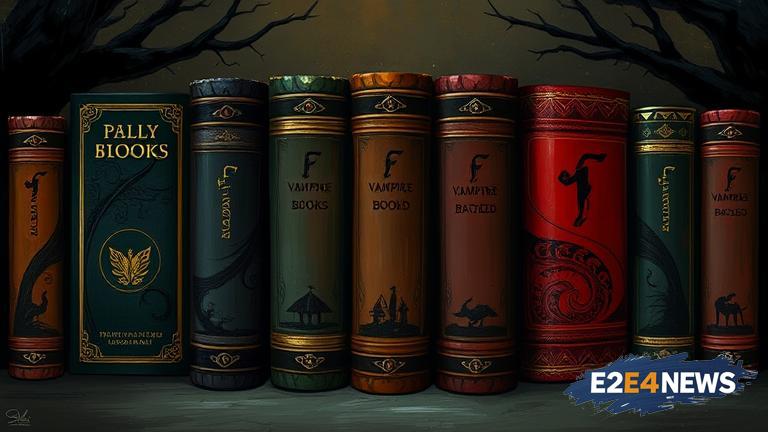The world of vampire literature is rich and diverse, spanning centuries and captivating readers with its unique blend of horror, romance, and suspense. From the earliest known vampire stories to modern-day bestsellers, these books have become an integral part of our cultural heritage. One of the most iconic vampire books is, of course, Bram Stoker’s ‘Dracula’, published in 1897 and widely considered the father of all vampire novels. This Gothic horror masterpiece tells the story of Count Dracula, a bloodthirsty vampire who preys on humans, and the brave men and women who dare to challenge him. Another classic in the genre is John Polidori’s ‘The Vampyre’, written in 1819 and often credited as the first modern vampire story. This short novel explores the darker aspects of human nature and the dangers of unchecked ambition. Mary Shelley’s ‘Frankenstein’ is also often associated with vampire literature, although it does not feature vampires explicitly. Instead, it examines the consequences of playing God and the blurred lines between life and death. In the 20th century, authors like Anne Rice and Stephen King further popularized the vampire genre, introducing new characters and themes that continue to fascinate readers today. Rice’s ‘Interview with the Vampire’ is a seminal work that redefined the concept of vampires as complex, multidimensional beings with their own moral codes and motivations. King’s ‘Salem’s Lot’, on the other hand, is a chilling tale of small-town America overrun by vampires, exploring the darker aspects of human psychology and the power of evil. Other notable mentions include ‘The Vampire Lestat’, ‘The Queen of the Damned’, and ‘The Passage’, all of which offer unique perspectives on the vampire mythology. In recent years, the rise of young adult fiction has led to a new wave of vampire books, such as ‘Twilight’ and ‘The Vampire Academy’, which have captivated a new generation of readers with their blend of romance, action, and supernatural drama. Despite the many variations and interpretations of vampire literature, certain themes and motifs remain constant, including the struggle between good and evil, the dangers of desire and temptation, and the human condition. Whether you’re a fan of classic horror or modern fantasy, there’s a vampire book out there for everyone, offering a glimpse into a world of darkness, mystery, and eternal life. With their richly atmospheric settings, complex characters, and timeless themes, these masterpiece vampire books continue to enthrall readers, inspiring new adaptations, interpretations, and works of fiction. The enduring appeal of vampire literature lies in its ability to tap into our deepest fears and desires, exploring the unknown and the unknowable with a sense of wonder and awe. As a result, these books have become an integral part of our shared cultural heritage, influencing countless other works of fiction, from film and television to music and art. In conclusion, the world of vampire literature is a vast and wondrous place, full of masterpieces that continue to captivate and inspire readers around the world. Whether you’re a seasoned fan of the genre or just discovering its many delights, there’s never been a better time to explore the timeless tales of the undead. With their unique blend of horror, romance, and suspense, these books are sure to leave you spellbound, eager to return to the world of vampires again and again. The impact of vampire literature on popular culture is undeniable, with references to these books appearing in everything from music and film to fashion and art. As a result, these masterpieces continue to shape our understanding of the world, influencing the way we think about good and evil, life and death, and the human condition. By exploring the many themes and motifs of vampire literature, readers can gain a deeper understanding of themselves and the world around them, discovering new insights and perspectives that continue to inspire and captivate us to this day.
